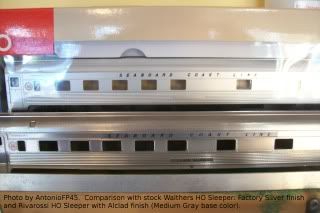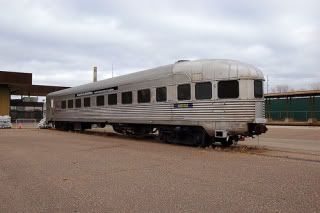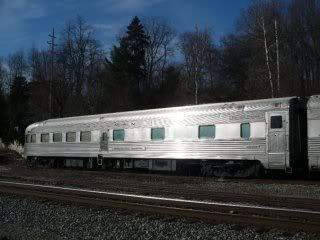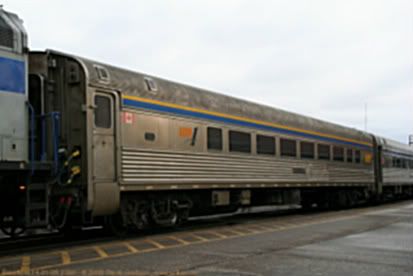Hello,
how big is the color difference of the silver paint between the newer plated and the older unplated Budd streamliner cars by Walthers?
Would it still look ok if both car types are combined in one train or is the difference too big?
Hello,
how big is the color difference of the silver paint between the newer plated and the older unplated Budd streamliner cars by Walthers?
Would it still look ok if both car types are combined in one train or is the difference too big?
I’ve not made a direct comparison, but I’ve read a lot of discussion on this. My take is the only time it really matters is if you’re running the train as it appeared right after it was put into service. With the passage of time, there was enough variation that the difference is within the range of prototypical appearances.
Of course, we’re talking about something that can be a highly subjective judgment by eye. This works for me, but YMMV.
Hello DeLuxe,
I hope this helps. On the photo below, I placed a Rivarossi sleeper that I metalized in front of a stock Walthers sleeper. You can see the difference. But keep in mind that the current Walthers plated units are “slightly lighter” in tone than the car I metalized in the photo.

Just my opinion, but to me silver paint on an HO ss passenger car has the appearance of stainless steel that has faded severely.
But you should not be too apprehensive. Stainless steel’s appearance is affected by a variety of factors including: maintenance (or lack of it), environments traveled in, temperature variations, age, etc. Look at the photos below of the same observation car.
Here her surface is faded to a lighter tone from age and the elements and it’s obvious it has not been polished in a long while. This, to me, could be represented by silver:

Now the same car after restoration and a good polishing job:

There a plenty of photos and even YouTube clips where you can see that stainless steel cars within the same train and even the same manufacturer did not always match.
May be a bit difficult to see, but look at this VIA photo by David Graham. Note the two Budd cars. The first unit is covered with grime, rail dust, brake dust, and earth while the 2nd Budd car is obviously cleaner. Yet, it’s interesting how the Stainless Steel’s surfaces look so different from each other.

Respectfully, my sugge
Having a variation between cars, even ones supposedly the same color, makes the train look more realistic IMO. Rarely - maybe on publicity shots and the first ocuple fo runs - did the entire consist of a train have all perfectly matching identical looking cars. After that, differnces in weathering, location of service, etc gave everythign a slightly different appearance.
–Randy
Thanks everybody for the information.
I want to model an early 50s 12-car streamliner train, and all what´s left for that train are 4 coaches which I still need to complete the consist. Since the unplated cars are completely sold out, the only thing what´s left for me is going for the plated ones. Maybe I take some sliver paint and paint all the 12 cars with it, so they will all look the same. Since it is a early 50s streamliner train, the appereance of all cars should be matching, because in those times top streamliner trains were mostly kept in top condition and the railroads really cared about a flawless appereance of their most representative trains. It would just look really odd for me if the 8 other cars of the train have one color and the 4 plated coaches another one.
I would really like to see a youtube video with plated and unplated Walthes cars combined into one train, but still I didn´t find such stuff yet.
Please don’t! If you can airbrush, try the Alclad route as the results will look so much more realistic. I’ve posted several threads on the process. Here’s one of them:
http://cs.trains.com/TRCCS/forums/t/195132.aspx
Unlike in the past, metalizing has become much, much easier with more realistic results for scale modelers. Look at my avatar.
If I can be of help, just contact me off list with a PM message.
[:D]